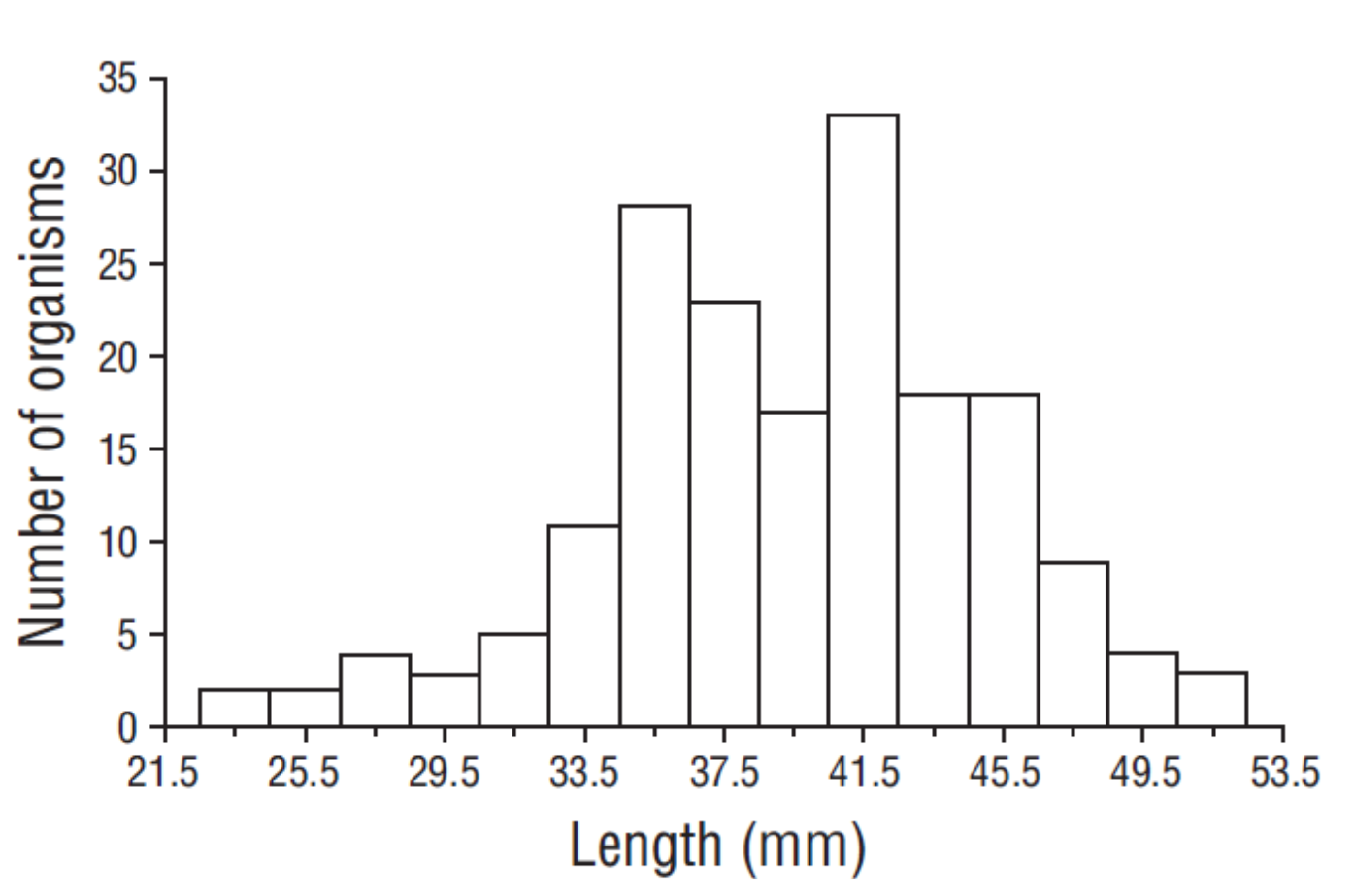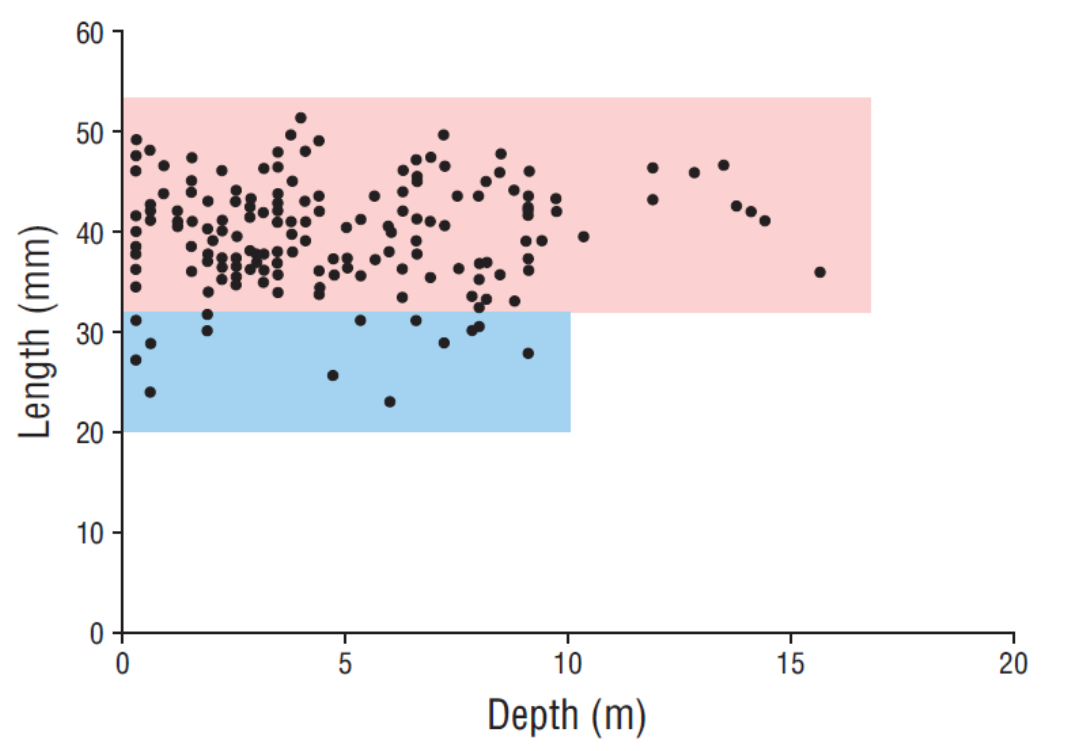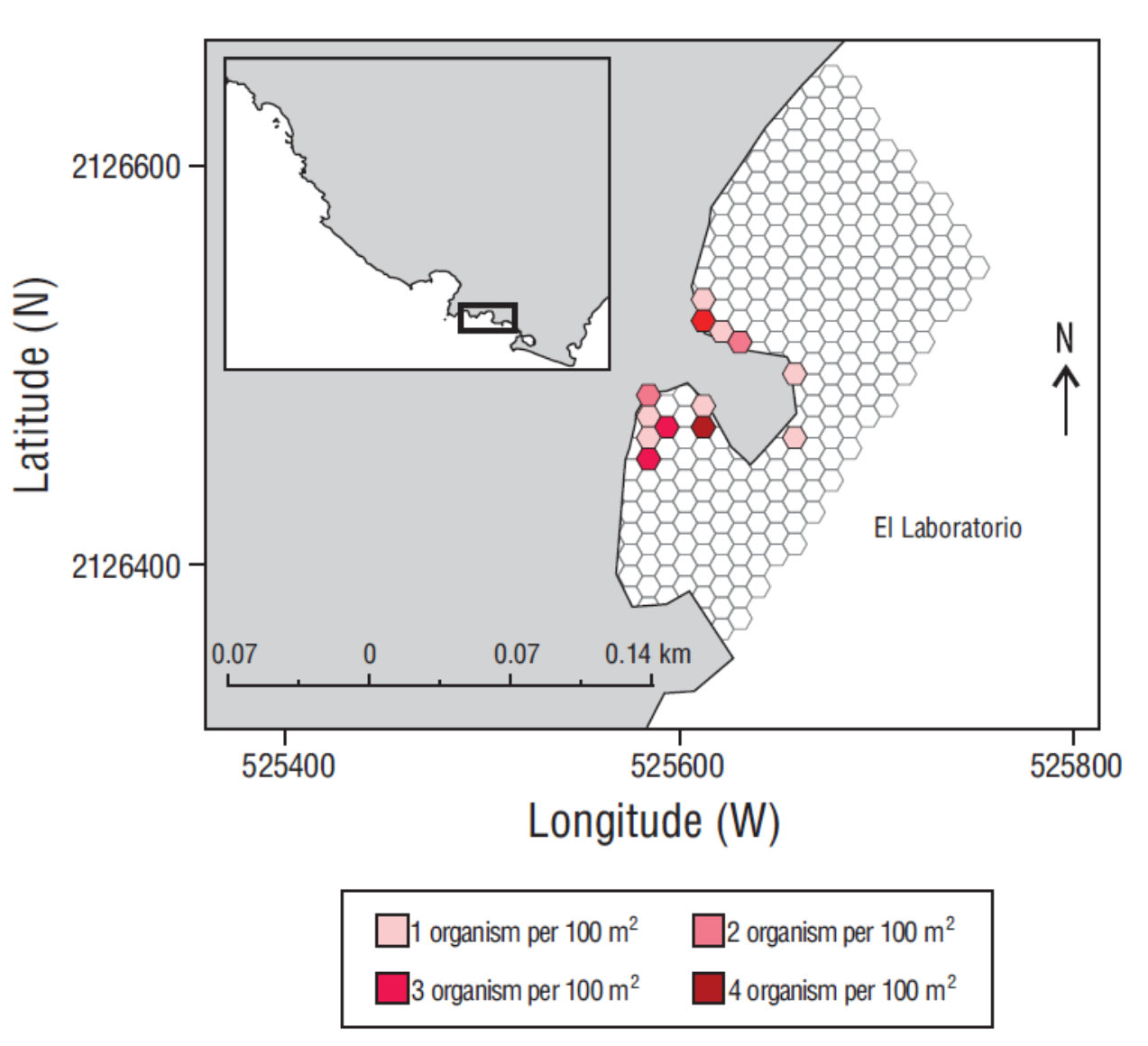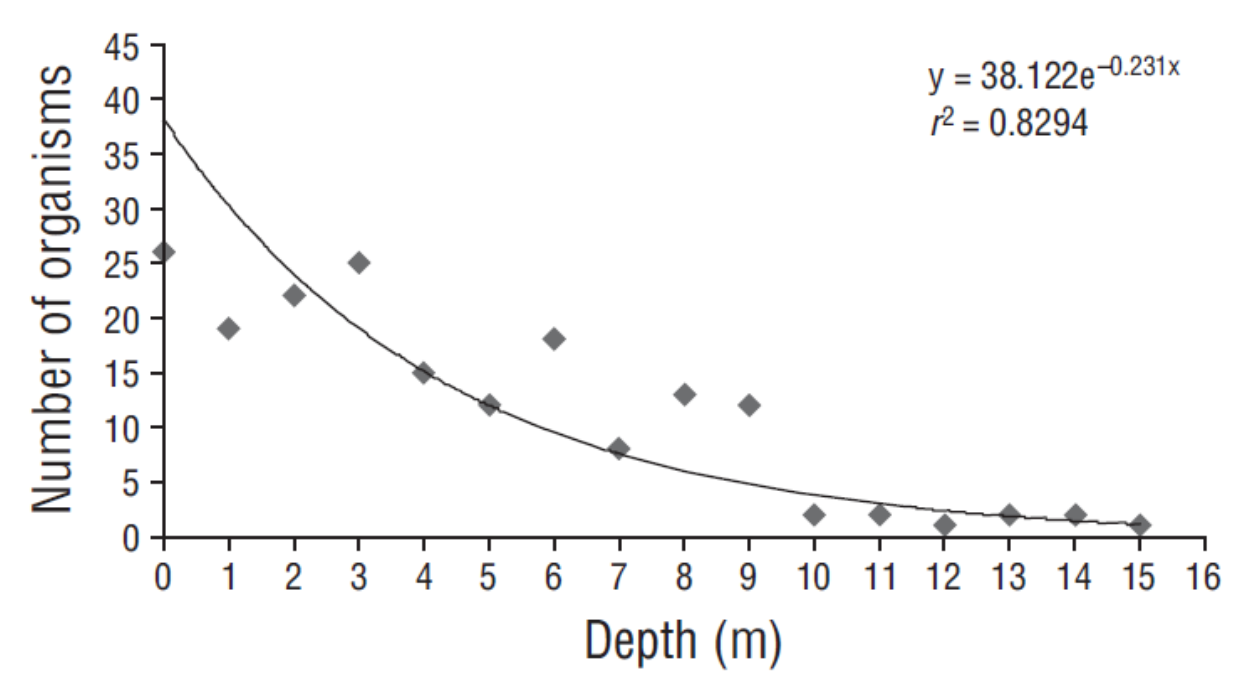Introduction
Cone snails, so called after the shape of their shells, constitute a genus of the Conidae family (Prosobranchia: Neogastropoda). They are considered the most diverse mollusk genus (Ponder 1973, Kohn 1990, Bandyopadhyay et al. 2008), with 803 extant species (WoRMS 2018) and 841 fossil species (Duda and Kohn 2005). Cone snails are found mainly in tropical oceans, from the subtidal zone to 1,000-m depth, and inhabit various types of substrate, such as rock, sand, mud, and seabed covered with vegetation or coral reefs (Dance and von Cosel 1977, Díaz-M et al. 2005). The species studied here, Conus princeps Linnaeus, 1758, is distributed from the Gulf of California, Mexico, to the northern coast of Peru (Keen 1971).
The evolutionary success of cone snails is attributed mainly to their sophisticated feeding method, which allows them to efficiently hunt using a modified radula to inject paralyzing toxins (conotoxins) into their prey (Nybakken 1970, López 2001). To hunt, cone snails use their venom apparatus, which produces venom and includes the injection mechanism (Marshall et al. 2002). Conotoxins are peptides that, after being synthesized in the venom apparatus, are injected through the chitinous, hypodermic needlelike radular teeth generated in the radular sac (Marshall et al. 2002). These toxins have been studied since the 1960s, when their pharmacological potential was discovered (Khon 1956). Up until 2007 80 medical patents were derived from these toxins (Kohn and Anderson 2010). At present, there is one drug, called Prialt, that is synthesized from the venom of the snail Conus magus Linnaeus, 1758 and is used on patients who experience intense pain (EMA 2014).
Particularly for C. princeps, Medina-Elizalde (2012) found that the species produces toxins with capacity to block ion channels. Gorrostieta-Hurtado et al. (2012) analyzed the effect of venom extracts from 3 different parts of the venom duct and found different regions of toxin biosynthesis. Zamora-Bustillos et al. (2014) and Morales-González et al. (2015) characterized conotoxins from 3 Conus species on the coast of Jalisco (Mexico), including C. princeps. More recently, Bernáldez et al. (2016) isolated a new conotoxin from this species.
Despite all the above, there are few studies on the ecology and biology of C. princeps on the Pacific coast of Mexico. In Oaxaca, Medina-Elizalde (2010) described the morphology of C. princeps and Conus brunneus. On the other hand, in Guerrero, Flores-Garza et al. (2014) conducted a study on the family Conidae, including its distribution, abundance, size composition, and association with rocky substrates, but only recorded one C. princeps specimen. Ortíz-Arellano (2014) determined species richness and the biological, ecological, and anatomical aspects for 31 Conoidea species on the coast of Sinaloa, and reported that Conidae was the most representative family with 17 species, including C. princeps; only 3 C. princeps specimens were collected.
For the Pacific coast of central Mexico, Landa-Jaime et al. (2013) recorded the presence of C. princeps and 7 other species of the genus Conus associated with the Tenacatita coral reef, Jalisco. For the soft bottoms on the continental shelf of Jalisco and Colima, Michel-Morfín et al. (2014) recorded 9 species of the genus Conus, including C. princeps. Bastida-Izaguirre (2014) made out an inventory of invertebrates and fish in Chamela Bay, Jalisco, and highlighted the presence of 4 mollusk species of the genus Conus: C. brunneus, Conus nux, C. princeps, and Conus purpurascens. In the Pacific transition zone off Mexico, García-Hernández (2014) recorded 8 Conidae species in Point Tehuamixtle, close to Cabo Corrientes, Jalisco, and found very low densities of C. princeps. In a recent study, Cortez-Orozco (2017) found 5 Conus species in the subtidal zone on the coast of Jalisco.
Although there are some studies on this group of sea snails, the present study aims to determine particular ecological and population attributes for C. princeps along the southern coast of Jalisco to help expand knowledge on this species and provide elements to determine if preservation and protection measures are needed for populations of C. princeps, given its biomedical potential.
Materials and methods
The southern coast of Jalisco is part of marine ecoregion no. 17, which corresponds to the Mexican Pacific Transition (Wilkinson et al. 2009), and marine priority region no. 26 (Chamela-El Palmito) (Arriaga-Cabrera et al. 1998). The region has a narrow continental shelf measuring approximately 2,364 km2. Ocean current circulation in this zone is characterized by 3 events: one from February to April, with high influence of cold waters from the California Current; another from August to January, with warm waters from the Equatorial Countercurrent; and the third from May to July, with a mixing period when the 2 currents converge (Wyrtki 1965). These events produce dynamic water circulation and, consequently, variability in oceanographic conditions in the zone (Silva-Segundo et al. 2008, Ambriz-Arreola et al. 2012).
Thirteen sampling sites were selected from Navidad Bay (19º10′30″N, 104º41′30″W; 19º12′50″N, 104º42′45″W) to Chamela Bay (19º21′11″N, 105º01′43″W; 19º38′06″N, 105º12′30″W). Four direct searches of Conus snails were performed at each of the 13 sites (Fig. 1) at the lowest tides of the day between February 2001 and January 2014. Searches were performed in the rocky intertidal zone (0-1 m depth), shallow subtidal zone (1-5 m depth), and deep subtidal zone (5-20 m depth). Different subaquatic techniques were used depending on depth, such as snorkeling and scuba diving. All sampling areas were delimited using a GPS MAP60CSx (Garmin; Olathe, Kansas).
To determine snail distribution and abundance in the intertidal zone, a direct scanning survey was carried out, and total area coverage was delimited with the GPS data. Every time a snail was found, a 0.25-m2 PVC quadrant equipped with a 10-cm graduated scale and a ScubaPro depthometer was placed around the snail. A submarine photograph was taken with a Canon SD 1100 digital camera equipped with a Canon polycarbonate case. The condition of the organism (alive or dead) and data about its location (type of environment where it was found, depth, and number of individuals) were recorded. When complete organisms were found (shell and soft body), snails were collected in numbered plastic bags to obtain biometric data and determine the species. This process was repeated for samplings in the shallow and deep subtidal zones, except that a diver pulling a GPS buoy at the surface followed the bubbles of the 2 divers searching for snails to record the collection point. When visibility and depth conditions hindered visual communication, one of the divers inflated and released a colored balloon to signal that an organism had been found.
The process of recording biometric data consisted in measuring the maximum length and width of the shell (mm) with a digital vernier. Weight (g) was recorded with a scale that had a capacity of 100 g. This process was done aboard the vessel or on the beach in the supralittoral zone. To determine the general structure of the C. princeps population, biometric data was used to obtain average snail size at each site, a general size-frequency histogram, and the length-weight relationship.
For the spatial dispersion and relative density analyses, all GPS position records for C. princeps organisms were considered. Satellite images and ArcView 3.3 and ArcGis 9.3 (ESRI 2011) software were used to obtain the geographic location of each snail, total area sampled, and, with this, relative density (expressed as the number of organisms per unit area). The sampling polygon was obtained on a map that was created by assembling the satellite image and a hexagonal grid of 100-m2 cells.
A Friedman analysis of variance by ranks (nonparametric test) was done to determine significant differences in abundance data by depth stratum and between sampling sites. In addition, a Fisher’s nonparametric F-test was done (Zar 2010). These 2 tests minimized the risk of type I and II errors.
On the other hand, the nearest neighbor method was used to determine the spatial pattern for C. princeps at each sampling site. This method allows using the measurements of distance between organisms to determine an index, that indicates if spatial distribution is clustered (value near 0), random (value near 1), or uniform (value greater than 1). The value is obtained directly from the subroutine analysis in the ArcGis 9.3 program (ESRI 2011).
Environments with C. princeps individuals were characterized using the underwater digital images obtained during fieldwork. Percent substrate coverage was determined by analyzing the image with the Coral Point Count v.4.2 computer program (Kohler and Gill 2006).
Results
A total of 180 specimens of C. princeps were recorded at the 13 sampling sites along the southern coast of Jalisco. Conus princeps was more abundant at 3 sampling sites: Mora Beach (39 sea snails), Cuastecomates (34 sea snails), and El Laboratorio (24 sea snails). The highest abundance per stratum was observed in the shallow subtidal zone at Mora Beach (22 sea snails) and the deep subtidal zone at Cuastecomates (19 sea snails) (Table 1). Average sea snail abundance considering all beaches was 13.84 ± 6.31, with a maximum of 39 sea snails and a minimum of 4 sea snails.
Table 1 Conus princeps abundance and relative population density by sampling site and zone.
| Intertidal | Shallow subtidal | Deep subtidal | Total abundance | Total density* | ||||
| Site | Abundance | Density* | Abundance | Density* | Abundance | Density* | ||
| Corrales | 0 | 0 | 3 | 0.141 | 2 | 0.320 | 5 | 0.153 |
| El Caballito | 0 | 0 | 6 | 0.282 | 8 | 0.330 | 14 | 0.293 |
| Cuastecomates | 3 | 0.097 | 12 | 0.165 | 19 | 0.593 | 34 | 0.25 |
| La Calechosa | 4 | 0.036 | 1 | 0.015 | 0 | 0 | 5 | 0.021 |
| El Laboratorio | 3 | 0.924 | 11 | 0.337 | 10 | 0.466 | 24 | 0.418 |
| Dorada Beach | 1 | 0.102 | 7 | 0.094 | 4 | 0.163 | 12 | 0.11 |
| El Tamarindo | 1 | 0.018 | 4 | 0.026 | 1 | 0.015 | 6 | 0.022 |
| Las Coloradas | 0 | 0 | 1 | 0.038 | 3 | 0.0312 | 4 | 0.105 |
| Mora Beach | 12 | 0.039 | 22 | 0.094 | 5 | 0.085 | 39 | 0.064 |
| Careyitos/Careyes | 1 | 0.020 | 7 | 0.063 | 1 | 0.012 | 9 | 0.037 |
| Paraiso Beach | 0 | 0 | 7 | 0.040 | 0 | 0 | 7 | 0.027 |
| El Negrito | 1 | 0.369 | 8 | 0.225 | 1 | 0.233 | 10 | 0.235 |
| Pajarera Island | 0 | 0 | 3 | 0.259 | 8 | 0.243 | 11 | 0.246 |
* Individuals per 100 m2.
For relative density of sea snails per beach stratum and the total per beach, maps were generated with the georeferenced field data for each sampling site. Because of space limitation, the only map shown is that for the site that showed the highest relative density (0.418 sea snails per 100 m2), El Laboratorio Beach (Fig. 2), which is located inside Cuastecomates Cove. Results showed high variability in relative density estimates for the different beaches, with values between 0.021 and 0.418 sea snails per 100 m2 and an average of 0.152 sea snails per 100 m2 (Table 1).
The Friedman analysis of variance by ranks did not show significant differences between the densities at each stratum and the sampling site (χ 2 r = 2 and χ 2 r 0.05,3,13 = 6). Fisher’s F-test showed coinciding results, given that the F f value was lower than F 0.05(1)2,12 (F f = 1 and F 0.05(1)2,12 = 3.8).
Sea snails in the C. princeps population on the southern coast of Jalisco measured between 23.1 and 52.5 mm. The population was composed of mainly sea snails with shells measuring between 35.5 and 41.5 mm total length. The mode for total length was 41.0 mm (33 sea snails) (Fig. 3). Average length for all sampled sea snails was 39.7 mm ± 0.84 (n = 172).

Figure 3 Histogram showing size-fequency distribution for Conus princeps on the southern coast of Jalisco.
Variability was observed in the average size of sea snails per sampling site. La Calechosa showed the highest average size per sampling site, with an average sea snail size of 46.4 mm. Dorada Beach showed the minimum average size with 36 mm (Table 2). No trend was observed relating size with the latitude of sampling sites.
Table 2 Nearest neighbor index value and length measurements for Conus princeps by sampling site.
| Site | Nearest neighbour index | Type of distribution | Maximum length (mm) | Minimum length (mm) | Average length (mm) |
| Corrales | 3.68 | Uniform | 45.9 | 28.7 | 37.2 |
| El Caballito | 0.69 | Clustered | 52.5 | 30.3 | 39.9 |
| Cuastecomates | 0.66 | Clustered | 49.5 | 35.9 | 44.0 |
| La Calechosa | 11.61 | Uniform | 49.0 | 41.5 | 46.4 |
| El Laboratorio | 0.82 | Random | 52.5 | 23.1 | 38.6 |
| Dorada Beach | 0.44 | Clustered | 48.0 | 25.6 | 36.0 |
| El Tamarindo | 2.11 | Uniform | 46.5 | 23.8 | 39.6 |
| Las Coloradas | 3.52 | Uniform | 45.0 | 36.7 | 39.8 |
| Mora Beach | 0.49 | Clustered | 49.0 | 26.7 | 37.1 |
| Careyitos/Careyes | 0.41 | Clustered | 46.0 | 38.0 | 42.0 |
| Paraíso Beach | 0.60 | Clustered | 45.0 | 35.4 | 41.2 |
| El Negrito | 0.78 | Random | 46.0 | 31.5 | 38.9 |
| Pajarera Island | 0.65 | Clustered | 45.0 | 30.0 | 38.1 |
The nearest neighbor index showed that for most sampling sites (53.8%) the spatial distribution of C. princeps was clustered; nonetheless, sea snail distributions for some sites was uniform (30.8%) or random (15.4%) (Table 2).
The dispersion diagram with the size-weight relationship data showed a b value very close to three (2.9) and a good fit to the potential regression model (r 2 = 0.80, n = 172); therefore, we can say sea snails showed an allometric growth pattern (Fig. 4).
The assessment of the total number of sea snails in the depth interval considered in this study (0-20 m) showed that individuals of the C. princeps population on the southern coast of Jalisco were distributed between 0 and 15.6 m depth and were more abundant from 0 to 4 m depth at all sampling sites. Different models were tested, and the best fit was obtained with the negative exponential model, which showed a determination coefficient of 0.82. This relation showed that the presence of sea snails decreased with depth (Fig. 5). Another observable trend was that larger organisms (>32.5 mm) were distributed at all depths between 0 and 16 m (Fig. 6, red rectangle), whereas smaller organisms were limited to <9 m depths (Fig. 6, blue rectangle).

Figure 6 Observed relationship between sampling depth and Conus princeps size on the southern coast of Jalisco. Red, large individuals; blue, small inividuals.
A total of 90 underwater images were processed and analyzed with the Coral Point Count software. Images showed that C. princeps individulas were found on 7 substrate types. Once the images were processed, the rock-with-algae substrate was determined as the preferential habitat (68%) (Fig. 7), followed by seashell debris and sand (10%), rocks with barnacles (8%), sand (6%), coral (4%), mixed substrates (3%), and gravel (1%) (Fig. 7).
Discussion
There are few studies on the population of C. princeps on the southern coast of Jalisco, and most of the studies have focused solely on the presence or absence of the species in taxonomic lists or on their conotoxins. For the study area, Landa-Jaime (2013) and Cortez-Orozco (2017) mention the presence of 5 Conus species: C. brunneus, Conus gladiator, C. nux, C. princeps, and C. purpurascens. The same 5 species were observed in the present study, where C. princeps was the third most abundant with 17% of total abundance, only after C. nux (45%) and C. brunneus (20%). In the Tenacatita coral reef, Landa-Jaime (2013) found the same abundance order for the species, but showed important variations in percentages, with C. nux as the most abundant species representing 62% of total organisms and C. princeps showing only 4.7%. Muñiz-Castillo (2014) mentioned that in the Carrizales coral reef, Colima (Mexico), C. nux was the most abundant species with 94.1% of total organisms and that C. princeps was the second most abundant with only 3.8%. We consider that C. princeps abundance is medium to low, with respect to the other 5 species discussed in these studies.
In our study we were able to estimate relative density, but we had to use the number of sea snails per 100 m2 as a unit, indicating that the observed densities are very low. Densities for the C. princeps population on the southern coast of Jalisco varied but were low in general, since they ranged from 0.021 to 0.418 sea snails per 100 m2 (average of 0.152 sea snails per 100 m2). Landa-Jaime (2013) reported a density of 1.3 organisms per 200 m2 for the Tenacatita coral reef. Muñiz-Castillo (2014) observed that densities for the Carrizales coral reef were different depending on the used sampling method: a density of 0.55 organisms per 100 m2 was determined using linear transects and a density of 0.27 organisms per 100 m2 was determined using random polygons. However, the methodologies used in both studies result in important differences, and it is therefore not possible to have a true reference point. To determine the population status for this species, it is important to unify the sampling methods used for other sites on the Pacific coasts.
Size structure varied from 23.5 to 51.5 mm shell length, and the largest percentage of organisms was found in the 41.5-mm size class. The histogram observed in the present study is consistent que the size-frequency distribution histograms reported by Landa-Jaime (2013), who showed that the C. princeps population was delimited by total length sizes of 25 to 50 mm and that organisms measuring 40 mm in length were the most abundant. Gorrostieta-Hurtado et al. (2012) collected C. princeps specimens with average lengths of 45 and 50 mm in the Tenacatita coral reef and Cuastecomates, respectively, which is consistent with the observed sizes for organisms collected in the same region in the present study. Muñiz-Castillo (2014) recorded 26 to 46-mm sizes for C. princeps. Flores-Garza et al. (2014) reported a single organism measuring 31.5 mm. In general, the sizes reported in the present study coincide with those reported in all the previous studies.
Size and weight data indicate that these sea snails exhibit allometric growth patterns, at least those in the observed size interval. It would be convenient to try to fit a growth model by using data from mark/recapture samplings or by tracking sizes across time to establish the relationship between the size and age of organisms and to determine juveniles sizes and recruitment periods, as has been done for other sea snail species in the intertidal zone (Michel-Morfín et al. 2000, Cervantes-Hernández et al. 2016).
Spatial dispersion is an important attribute for species because it can indicate mating aggregations, feeding aggregations, or aggregations that are dependent on prey microhabitats. On the other hand, in territorial species, spatial dispersion can indicate uniform distribution as a result of exclusion or competition. This was observed by Landa-Jaime (2013) for C. purpurascens, a piscivorous species that exhibits uniform distribution. In the case of C. princeps, the 3 types of spatial distribution were observed, but the most frequent one was the clustered type. This type of distribution could be explained by its feeding habits because, although it has not been observed feeding in the laboratory or the field, the shape of its radula suggests that it feeds on polychaetes (Ortíz-Arellano 2014). Therefore, sea snails could be aggregating around microhabitats that show optimum conditions for prey growth. Since sampling was done over a long period of time, changes in the observed distribution patterns between sampling sites could be explained by variations in the behavior of sea snails.
With respect to substrate affinity, C. princeps showed preference for rocks covered with algae (68%). Ríos-Jara et al. (2006) mentioned that this species is associated with rocky substrates and rocks covered with algae. Landa-Jaime (2013) mentioned that C. princeps preferred 3 substrate types and that it was most abundant (57%) on coral substrates; however, the study was carried out at the Tenacatita coral reef. We have to consider that substrate preference could be determined by prey availability, the ease of going unnoticed while hunting, or the low chances of being hunted. To avoid bias in sampling site selection, we considered various sites along a latitudinal gradient with different characteristics; therefore, we believe that the results obtained in the present study are representative of the population on the southern coast of Jalisco.
The information presented in this study will contribute to knowledge on the sea snail C. princeps. Nevertheless, more studies on the biology of this species are needed because relevant aspects such as its reproductive season, growth, recruitment, and precise feeding habits, among others, have been scarcely studied and are necessary, together with specific studies on its toxicology, to learn more about this natural resource.
It is worth mentioning that after carrying out field activities at 13 sampling sites along the southern coast of Jalisco, which included 3 different environments and a bathymetric range between 0 and 20 m depth, only 180 live specimens of C. princeps were collected, indicating that this species is not abundant or is hard to find. This could be a reason for considering the establishment of long-term conservation measures for this species, such as restricting extraction of individuals or determining reserve zones or national parks. For sea snails of the genus Conus, in general, knowledge on the properties and biomedical applications of their toxins has shown advancements; however, other basic aspects, such as their distribution, abundance, basic population biology, and true number of species in Mexican waters, should also be studied.











 nueva página del texto (beta)
nueva página del texto (beta)







